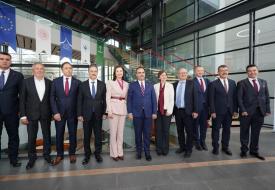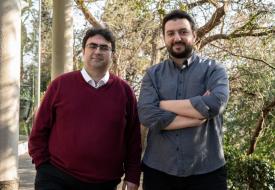Thanks to UzMAn's microalgae, oxygen production in space becomes feasible
As a key initiative within Turkey's National Space Programme, the "Microalgal Life Support Units for Space Missions" (UzMAn) project, developed in collaboration between Boğaziçi University, TÜBİTAK Marmara Research Centre (MAM), and Istanbul Medeniyet University (IMU), stands out among the 13 projects launched into space for cutting-edge experiments.
Following experiments conducted by Turkey's first astronaut, Alper Gezeravcı, on the International Space Station, data analysis by project coordinator Dr. Berat Zeki Haznedaroğlu and his team at Boğaziçi University Institute of Environmental Sciences revealed that algae possess the ability to convert three to five times more carbon dioxide into oxygen in a microgravity environment compared to enclosed spaces. This discovery holds significance for the development of life support systems in space and the provision of oxygen during long-duration space missions.

"THE PROJECT HAS THE POTENTIAL TO CONVERT THE ENTIRE DAILY CARBON DIOXIDE OF THREE CREW MEMBERS INTO OXYGEN"
After successfully reaching the International Space Station, Alper Gezeravcı wasted no time in connecting the experiment to the system in the Columbus module of the European Space Agency (ESA). With everything set up, he initiated the experiment and the team on the ground started receiving the first set of data from the satellite via the ground computer.
The scientist added a carbon dioxide enrichment unit, designed by researchers at TÜBİTAK MAM, a project partner, to the experiment. This addition was aimed at pushing the algae further and conducting a study that had not been done previously. The scientist then shared some initial results from the experiment.
"In the experiment, three distinct microalgae types were tested – two sourced from polar regions and one adaptable to both fresh and saltwater environments. On the experiment's final day, astronaut Alper Gezeravcı, our first astronaut, carefully transferred the microalgae species into a specially prepared protective solution, ensuring their preservation. The algae, preserved in a cold chain, were returned to Earth and safely reached Boğaziçi University. During the experiment, we elevated carbon dioxide levels from approximately 500 parts per million to 2,000 to 2,500 parts per million. Notably, our data revealed a roughly one-third reduction in carbon dioxide at these heightened levels. Despite using small 30-milliliter reactors, we observed remarkably high oxygen conversion rates in the filled systems. The UzMan experiment has convincingly demonstrated the potential of utilizing algae to positively impact environmental conditions. Our findings suggest that a medium-sized microalgae reactor, if appropriately scaled, holds the capability to convert all the carbon dioxide consumed by three crew members in a day into oxygen."

"WE HAVE PROVEN THAT WE CAN USE ALGAE FOR AIR PURIFICATION"
Dr. Assoc. Prof. Dr. Haznedaroğlu highlighted the successful performance of all three microalgae species sent into space, underscoring their potential for future missions. Emphasizing the reliance on physical and mechanical systems for converting carbon dioxide to oxygen on the space station, he explained the critical drawback of potential system failures, which could lead to extended cargo delivery times—up to six months or even a year in scenarios like colonization missions to the Moon or Mars. Such failures pose a significant risk to the crew's lives.
In contrast, Dr. Haznedaroğlu pointed out the invaluable advantage of algae being self-growing and renewable systems. The UzMAn experiment conclusively demonstrated the feasibility of utilizing algae for air decontamination, providing a promising alternative to traditional mechanical systems in space missions.

"WE WILL ALSO EXPLORE THE POTENTIAL OF MICROALGAE FOR FOOD PRODUCTION IN SPACE"
Dr. Assoc. Prof. Dr. Haznedaroğlu, expressing that within the project's scope, efforts will persist not only in oxygen production but also in addressing the food requirements for space missions through algae, stated the following:
"In the experiment's second phase, we will conduct a metabolic analysis of the algae, identifying optimal functional food products. We will also be able to demonstrate scientifically which mechanisms contribute more to their conversion to oxygen. People have exactly the same needs. They need energy, food. plants grown in space for various experiments require fertilizers, and animals may benefit from these resources. The acquired data also has potential applications in diverse commercial fields, ranging from the recovery of precious metals to hydrogen production."












